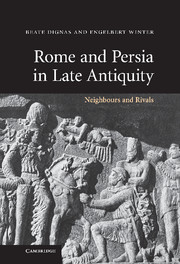Book contents
- Frontmatter
- Contents
- List of figures
- List of maps
- Preface
- Abbreviations
- Introduction: West and East, friend and foe, counterpart and mirror image …
- PART I NARRATIVE
- PART II SOURCES AND CONTEXTS
- 1 Political goals
- 2 Warfare
- 3 Military confrontations
- 4 The diplomatic solutions
- 5 Arabia between the great powers
- 6 Shared interests: Continuing conflicts
- 7 Religion: Christianity and Zoroastrianism
- 8 Emperor and King of kings
- 9 Exchange of information between West and East
- Appendix 1 Lists of Sasanian kings and Roman emperors
- Appendix 2 Chronological table
- Appendix 3 Glossary
- Bibliography
- Index of sources
- Index of translated sources
- Index of names
- Index of place names
- General index
9 - Exchange of information between West and East
Published online by Cambridge University Press: 05 June 2012
- Frontmatter
- Contents
- List of figures
- List of maps
- Preface
- Abbreviations
- Introduction: West and East, friend and foe, counterpart and mirror image …
- PART I NARRATIVE
- PART II SOURCES AND CONTEXTS
- 1 Political goals
- 2 Warfare
- 3 Military confrontations
- 4 The diplomatic solutions
- 5 Arabia between the great powers
- 6 Shared interests: Continuing conflicts
- 7 Religion: Christianity and Zoroastrianism
- 8 Emperor and King of kings
- 9 Exchange of information between West and East
- Appendix 1 Lists of Sasanian kings and Roman emperors
- Appendix 2 Chronological table
- Appendix 3 Glossary
- Bibliography
- Index of sources
- Index of translated sources
- Index of names
- Index of place names
- General index
Summary
Between neighbours and rivals there were plenty of opportunities to learn about the political strategies and customs of the other. In this context, it must be emphasised that a transfer of technology and a curiosity with regard to the foreign culture can be observed in both directions. Scholarly literature often refers to a ‘difference in the degree of civilisation’ between West and East – this is not justified. The title of this chapter has therefore been chosen deliberately in order to stress an ‘exchange’ rather than a one-sided process. To give but one example: on many occasions the Sasanian Empire functioned as a mediator of cultural possessions from the Far East and India, which were eagerly received by the West.
The opportunity for exchange was not limited to the official political and administrative realms. It can be observed in particular with regard to the border regions (map 14), namely Mesopotamia and Armenia or border cities such as Dārā, Amida and Nisibis, where a frequent change of rule took place. ‘Enmity did not isolate the two empires from each other … A common language … and identical customs prevailed on either side of the frontier, linking together related populations split asunder by political accidents.’ In particular the geographic conditions in Armenia and Mesopotamia as well as to the west and south-west of the Euphrates, where the Syrian Desert formed the actual border between the great powers, prevented any strict control of this part of the frontier.
- Type
- Chapter
- Information
- Rome and Persia in Late AntiquityNeighbours and Rivals, pp. 242 - 265Publisher: Cambridge University PressPrint publication year: 2007



